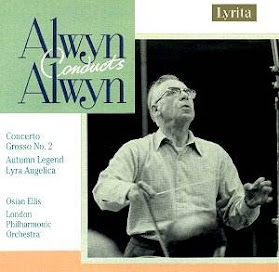Autumn Legend was composed for the 1955 Cheltenham Festival. Ian Johnson (2005, p.218) has noted that it was “partially inspired” by a visit that William Alwyn had made to Edvard Grieg’s house [in Troldhaugen] in the company of the poet Christopher Hassall.
It was completed during November 1954, whilst Alwyn was staying at Thornhill in Cowes, Isle of Wight (Wright, 2008, p.142). Autumn Legend is scored for cor anglais and string orchestra. The working title on the short score was ‘Poem for string orchestra with cor anglais obligato.’
Alwyn was a noted collector of
Pre-Raphaelite paintings, including some by Dante Gabriel Rossetti. He has stated
that Autumn Legend is “unashamedly romantic” and was his “personal
tribute to the memory” of the painter. He wrote that “the walls of my studio
were hung with Rossetti’s paintings and, often when I was composing, I
experienced the eerie sensations that Rossetti himself was in the room with me.”
(CHAN9065 liner notes).
In the entry in his diary, Ariel to Miranda for Monday, 25 June, (ed.
Palmer, 2009, p.219) Alwyn notes that Autumn
Legend was written in “a mood of nostalgia –A La Recherche du Temps
Perdu (Proust) and reflects in a short tone poem (the cor anglais is
considered as part of the orchestra) on the lines from Rossetti’s poem The
Blessed Damozel…” These were
included in the score: -
Surely she leaned o’er me – her
hair
Fell all about my face…
Nothing: the Autumn fall of leaves.
The whole year sets apace.
The Legend then, may be
considered as a “free improvisation” on the mood created by the words.
William Alwyn’s programme note (Wright, 2008, p.145) states that the paintings of Rossetti and Charles Condor, which were in his possession, “are a continual reminder that beauty vanishes, so the artist must capture the mood before it goes for ever.” He suggests that the “easy modern term is escapism” however he regarded “these moods as legitimate and necessary means of expression (neglected nowadays) and as different as chalk from cheese from the purely abstract problems when composing my symphonies.” He concludes by pointing out that this is music written “for love” and in the belief that “it will be listened to and enjoyed as such.”
The first performance was on 22 July 1955 at Cheltenham Town Hall with Roger Winfield as cor anglais soloist and the Hallé Orchestra conducted by Sir John Barbirolli.
The
Times (23 July 1955, p.8) reviewing the premiere considered that Autumn Legend nodded to Sibelius and was
“happy to brood” on the Finn’s achievement: they may even have imagined “returning
to the Kareol where the shepherd’s pipe still echoes, and where the black river
of Tuonela flows in the geographically unlikely distance under one of Debussy’s
cloudy skies.” Finally, the critic
considers that the “reminiscences are overt, but the music is agreeably
wistful, and the solo was most sensitively played by Mr. Roger Winfield.”
Martin Cooper writing in the Musical Times (September 1955, p.489)
considered that “William Alwyn's Autumn Legend, for cor anglais and
strings, was cruelly but not ineptly described by one wit as 'L'Apres-midi d'un
Cygne' - a rich and nostalgic threnody in which Bax, Delius and Mahler were
repeatedly echoed. These two works [the other was Gerald Finzi fine Cello
Concerto] undoubtedly reflect the taste of Sir John Barbirolli, who has a
large part in the choice of works to be played at this festival. I cannot see
that they have any place in a festival of contemporary music, because they only
repeat what has been said more effectively and with the force of creative
originality by other men whose works are still in the normal repertory.”
Autumn Legend was subsequently played during the 1955 Promenade Concerts at the Royal Albert Hall with the same soloist, orchestra and conductor. The previous work at that evening’s ‘Prom’ (2 September) had been Geoffrey Bush’s delightful but wayward Overture: Yorrick. The Times critic (September 3, 1955, p.8) notes that the “Legend is just as easy on the ear for those people who prefer not to be unduly provoked by modernity.” This can be a failing: “some listeners might even accuse the composer of taking refuge in the romanticism of a past era, so evocative is the music of things that have already been said before.” However, despite this degree of pastiche, the reviewer felt that the Legend “is the stuff of poetry and is most subtly and sensitively scored.”
Donald Mitchell (The Daily
Telegraph, 3 September 1955, p.9) simply stated that Autumn Legend
“is a rhapsody, beautifully written for the haunting melancholy timbre of the
instruments [cor anglais and strings].”
Johnson, Ian, William Alwyn: The Art of Film Music, The Boydell Press, Woodbridge, 2005)
Ed. Palmer, Andrew, Composing in Words: William Alwyn on his Art, Toccata Press, Chippenham, 2009)
Wright, Adrian, The Innumerable Dance: The Life and Work of William Alwyn, The Boydell Press, Woodbridge, 2008)
The files of The Daily Telegraph, The Times, The Musical Times, etc.

No comments:
Post a Comment